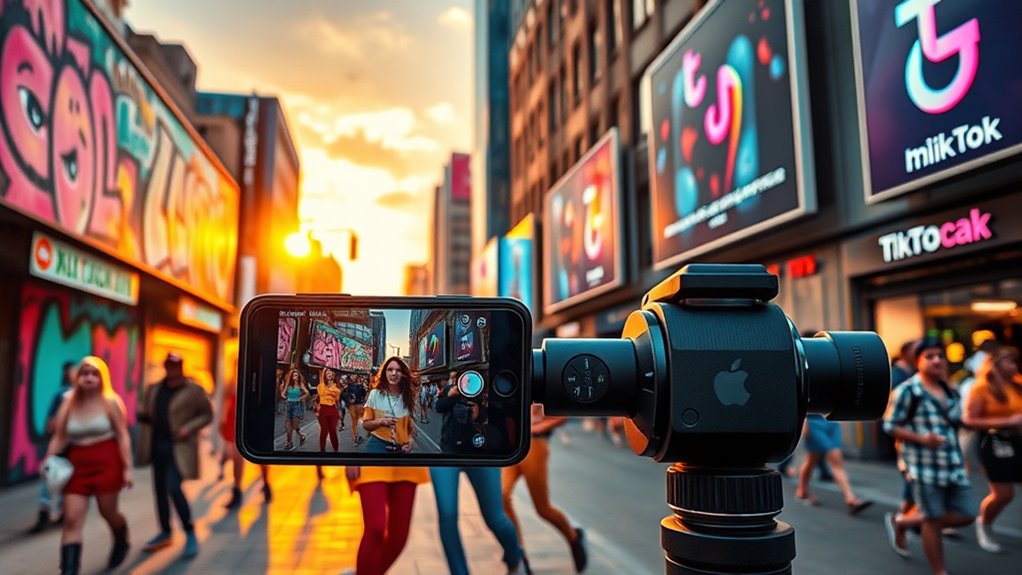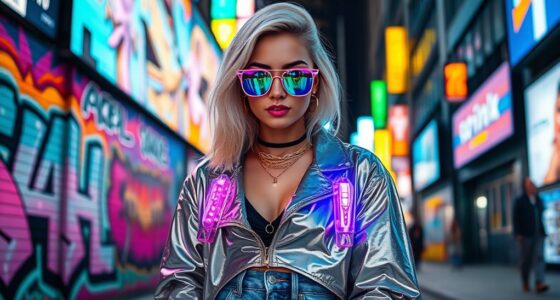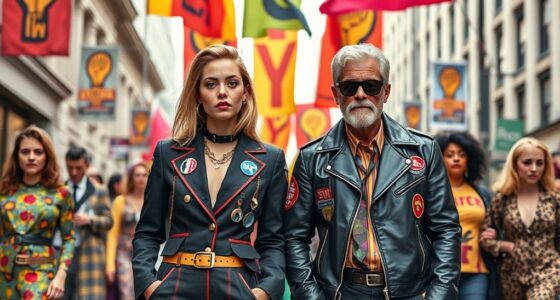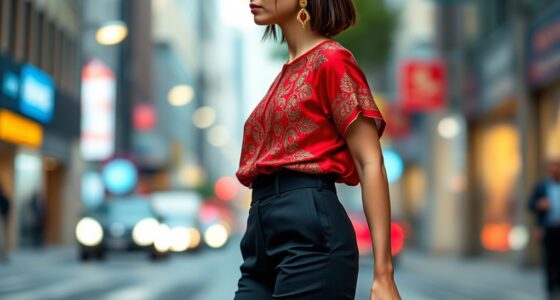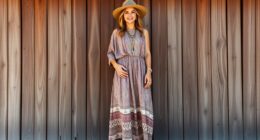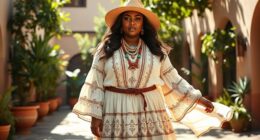Social media platforms like Instagram and TikTok have transformed fashion culture by making style more accessible, fast-paced, and personalized. You now see trends spreading instantly through viral videos, influencers shaping what’s in, and brands engaging directly with consumers. Visual stories evoke emotions and inspire trends, while democratization breaks barriers between high fashion and everyday style. If you want to understand how these platforms continue to shape the future of fashion, explore further.
Key Takeaways
- Instagram and TikTok democratized fashion by making high-end styles accessible to a global audience through visual content.
- They accelerated trend cycles with viral challenges, short videos, and influencer collaborations, shaping consumer preferences rapidly.
- These platforms foster diversity and authenticity, amplifying marginalized voices and challenging traditional beauty standards.
- Visual storytelling on social media deepens brand engagement, evoking emotions and inspiring cultural shifts in fashion.
- The rise of digital fashion and AR features on these platforms enhances immersive, sustainable, and personalized fashion experiences.
The Rise of Visual Storytelling in Fashion
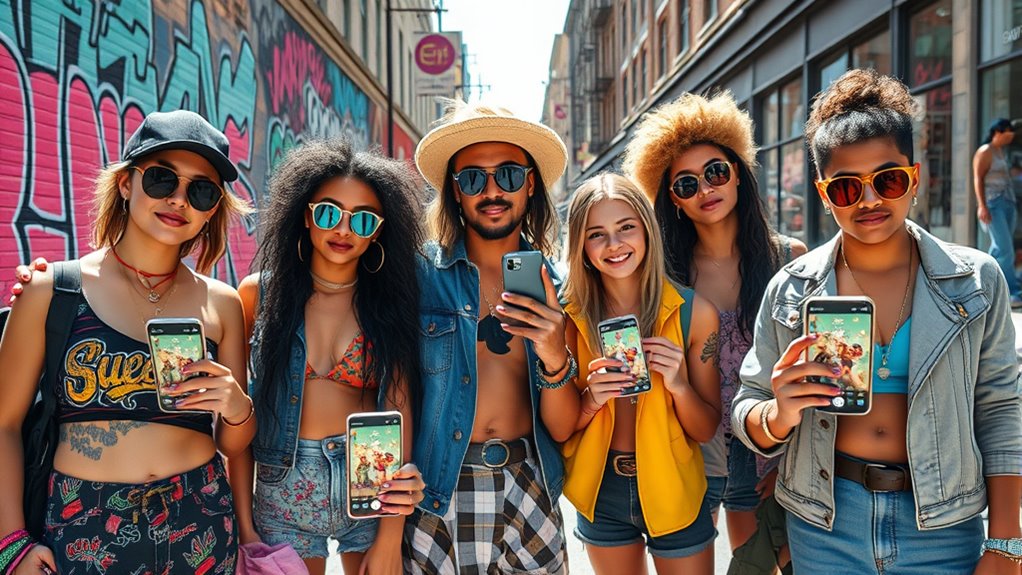
Visual storytelling has transformed the fashion industry by making brands and designers more accessible and engaging. You now experience a stronger visual impact through carefully crafted images and videos that convey a brand’s identity instantly. By using storytelling techniques like mood boards, behind-the-scenes footage, and thematic shoots, fashion brands create narratives that resonate deeply with audiences. These visuals don’t just showcase clothing—they tell stories that evoke emotions, inspire trends, and foster loyalty. You’re no longer just a passive viewer; you’re immersed in the story behind each collection. This shift encourages brands to prioritize visuals that communicate their message quickly and effectively, making fashion more relatable, memorable, and impactful in the fast-paced world of social media. The use of eye patches in makeup routines further exemplifies how visual elements can enhance personal presentation and self-care.
Democratization of Style: From Runways to Everyone’s Feed
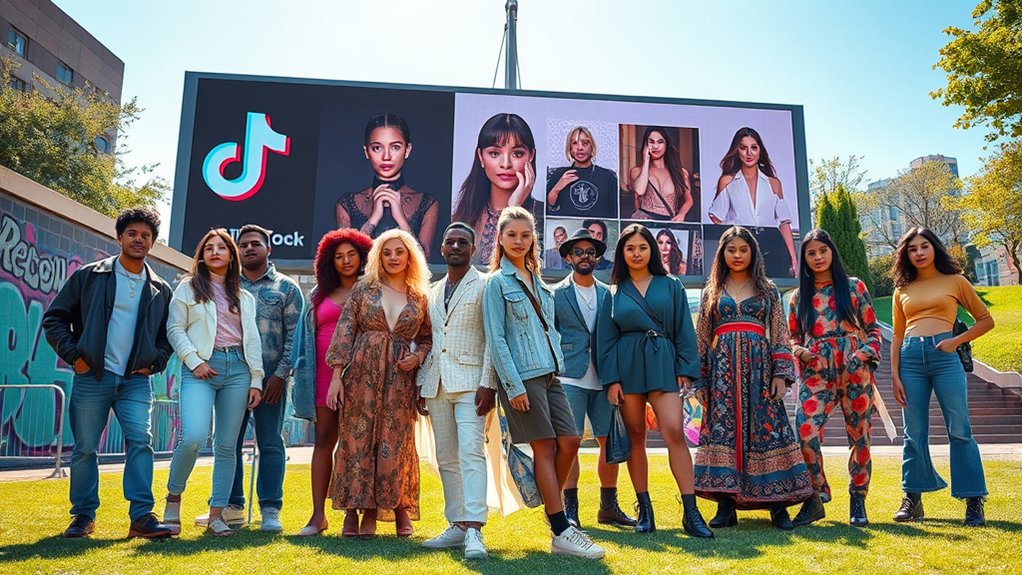
Thanks to social media, high fashion no longer stays confined to runways and exclusive boutiques; instead, it’s now accessible to everyone through your feed. You can explore sustainable fashion brands that emphasize eco-friendly materials and ethical production, making stylish choices more responsible. Luxury branding has also become more inclusive, as influencers and everyday users showcase affordable alternatives inspired by designer collections. This democratization of fashion allows you to see how runway trends translate into everyday wear, breaking down barriers between elite fashion and the masses. Now, you can adopt high-end styles without breaking the bank, while supporting brands committed to sustainability. Additionally, the rise of creative expression demonstrates how creativity and individuality are influencing various lifestyle choices, including fashion. Social media has truly transformed fashion into a more accessible, diverse space where everyone can express their personal style.
Viral Trends and Their Impact on Consumer Preferences
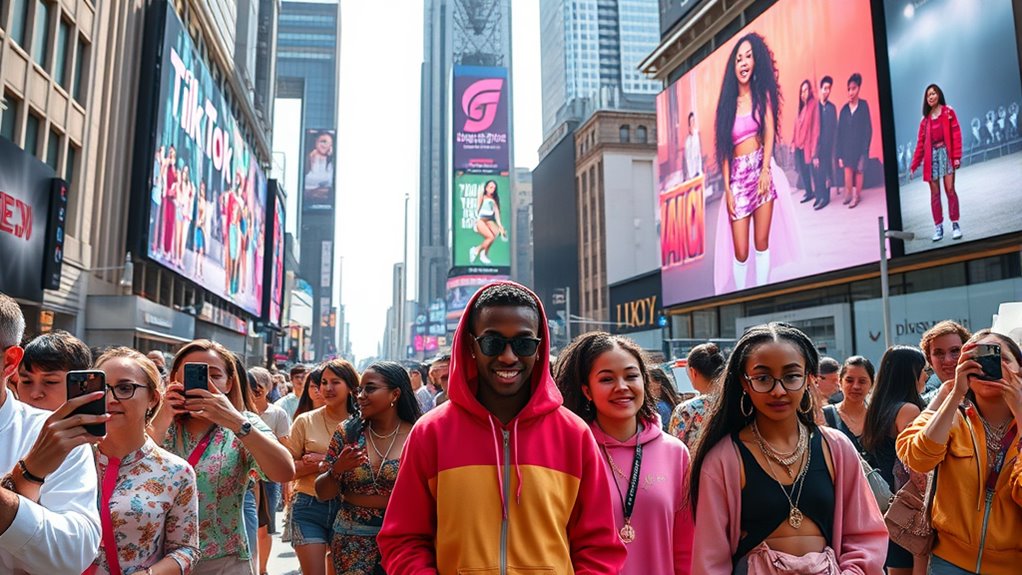
Social media’s rapid spread of viral trends has considerably reshaped consumer preferences, often turning fleeting moments into lasting shifts in fashion and lifestyle choices. You notice how a simple TikTok dance or Instagram challenge can spark demand for specific styles overnight. But, this influence isn’t always neutral.
- Algorithmic bias can amplify certain trends while hiding others, skewing your perception of what’s popular. For example, predictive modeling can influence which trends are promoted, further shaping consumer behavior.
- As trends go viral, privacy concerns grow, especially when sharing personal data to access exclusive content.
- These factors make your preferences susceptible to manipulation, shaping what you buy based on what algorithms prioritize rather than genuine interest.
- Recognizing how all water parks are promoted on social media can help you better understand the marketing tactics behind viral trends in leisure and lifestyle choices.
- The use of targeted advertising driven by social media algorithms can further influence your purchasing decisions by narrowing the options you see based on your online activity.
Ultimately, viral trends drive rapid shifts, but they also highlight the importance of being aware of how algorithms and privacy issues influence your consumer behavior.
Influencers and Creators Shaping Fashion Narratives
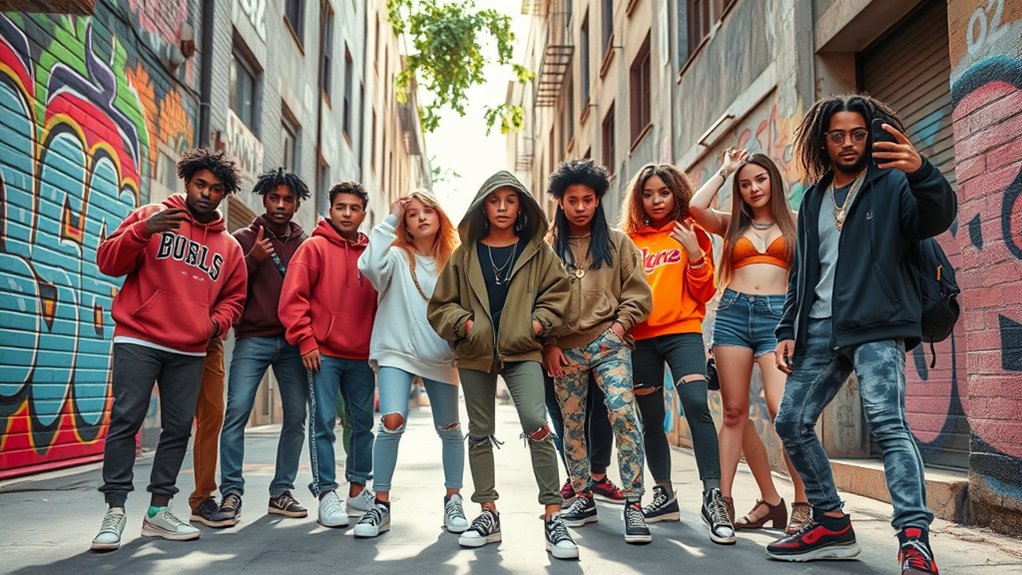
Influencers and creators hold significant power in shaping fashion narratives, often setting trends that followers enthusiastically adopt. They act as modern fashion icons, influencing what’s considered stylish and desirable. Their expertise in trend forecasting helps them introduce innovative styles quickly, making them key drivers of change. You can see their impact in how brands now prioritize collaborations with these creators to reach targeted audiences. To illustrate, here’s how influencers influence fashion:
| Role | Impact | Example |
|---|---|---|
| Trendsetters | Introduce new styles early | Launching viral outfit trends |
| Brand Ambassadors | Boost brand visibility | Promoting sustainable fashion |
| Trend Forecasters | Predict upcoming styles | Forecasting minimalism trends |
| Fashion Icons | Set lasting style standards | Influencing seasonal collections |
| Creators’ Power | Drive trends through content | Viral styling challenges |
The Role of Short-Form Videos in Fashion Marketing
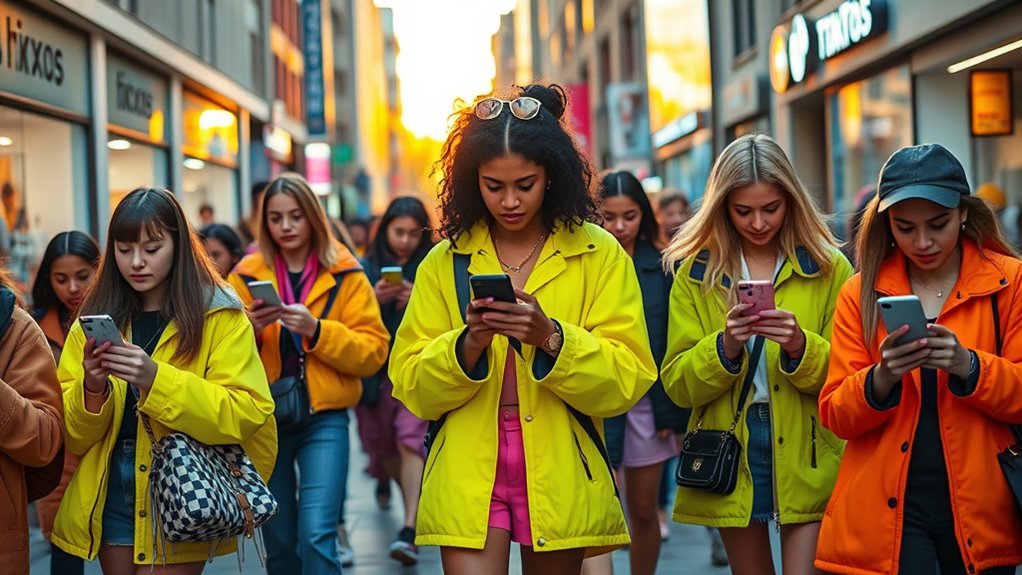
Short-form videos quickly create viral trends that catch your eye and influence buying decisions. They also amplify influencer impact, making fashion messages more relatable and widespread. By encouraging creative engagement, these videos keep your attention and drive interaction with brands. Additionally, their use of visual storytelling enhances the emotional appeal of fashion content, making it more memorable. Moreover, they facilitate active listening by prompting viewers to respond and participate, further strengthening the connection between consumers and brands. The dynamic nature of these videos allows for real-time feedback, which helps brands tailor their messages to current trends and audience preferences.
Viral Trends Generation
Because short-form videos have become a dominant force in digital culture, they play a crucial role in shaping viral trends in fashion marketing. You see, these videos fuel the spread of viral challenges and meme culture, making them powerful tools for brands. To understand their impact, consider these key points:
- Viral challenges encourage users to participate in fashion-related activities, amplifying brand visibility.
- Meme culture transforms quirky or trending videos into widespread phenomena, influencing style perceptions.
- Short videos allow quick, engaging content that spreads rapidly, often dictating what’s “in” or “out” in fashion.
- The use of high-quality visuals and color accuracy in these videos enhances their appeal and credibility, further boosting their virality.
- Additionally, leveraging AI content clusters helps brands organize and target trending topics more effectively, maximizing reach and engagement.
- Recognizing the importance of visual consistency across videos can also strengthen brand identity and improve audience retention.
Together, these elements drive the generation of viral trends, allowing fashion marketers to capitalize on organic, user-driven content that resonates widely and quickly.
Influencer Impact Amplification
How do short-form videos amplify the impact of influencers in fashion marketing? They leverage algorithmic influence to boost visibility, ensuring your content reaches a broader audience quickly. These videos allow influencers to showcase outfits, styling tips, and brand collaborations in engaging, bite-sized formats that captivate viewers. Because platforms like TikTok and Instagram prioritize fresh, trending content, your videos can go viral, considerably expanding your reach. This heightened exposure strengthens influencer branding, making your voice more recognizable and trusted. Short-form videos also enable influencers to demonstrate authenticity and creativity, fostering stronger connections with followers. Additionally, incorporating visual appeal through compelling visuals and editing enhances viewer engagement. The use of trending sounds and challenges further amplifies the content’s reach, tapping into the platform’s algorithmic influence. This synergy between content style and platform mechanics maximizes engagement opportunities. As a result, brands benefit from increased engagement and conversion, while influencers solidify their position as trendsetters within the fast-paced world of fashion marketing.
Engagement Through Creativity
The creative potential of short-form videos transforms how influencers and brands engage audiences in fashion marketing. By leveraging quick, visually compelling clips, you can boost user engagement through authentic creative expression. These videos invite viewers to participate, whether by recreating looks or sharing their own style stories. To maximize impact, focus on:
- Showcasing behind-the-scenes content to create transparency and trust
- Using trending music and effects to boost shareability and visibility
- Encouraging audience interaction through challenges and calls-to-action
This approach fosters a deeper connection, making followers feel part of your fashion narrative. Short-form videos turn passive viewers into active participants, elevating creative expression and strengthening brand loyalty in the fast-paced social media landscape.
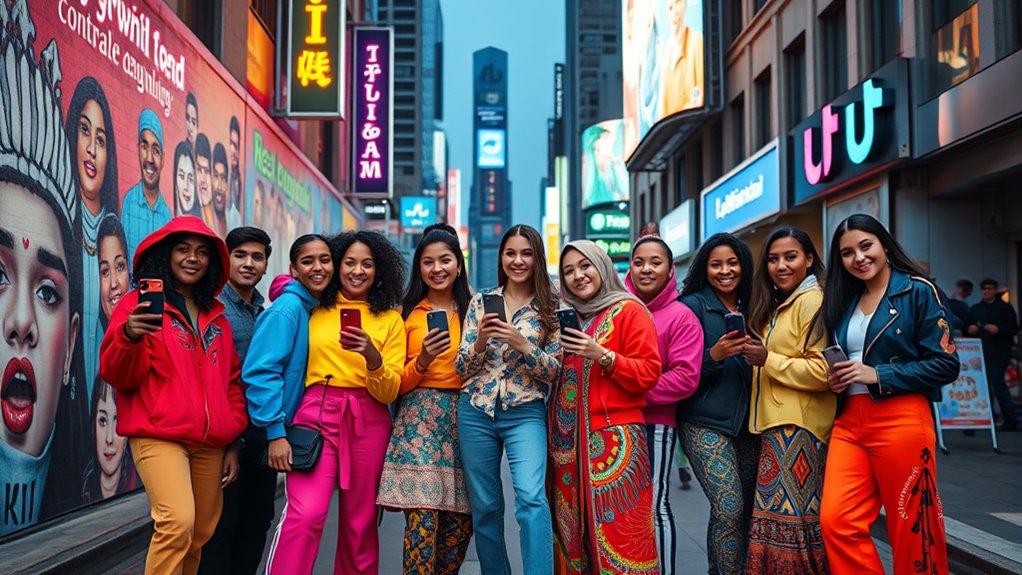
Social media platforms are increasingly becoming battlegrounds for breaking down barriers related to diversity and inclusion. You see, they allow for greater cultural representation, giving voices from all backgrounds a chance to be heard. This visibility challenges traditional beauty standards and promotes authentic stories that resonate worldwide. Platform accessibility plays a vital role too, enabling marginalized communities to share their experiences without gatekeepers. As a result, more diverse creators gain recognition, inspiring others to embrace and celebrate differences. Social media’s open nature helps foster conversations around racial, gender, and cultural identities, making inclusion a central part of the dialogue. Additionally, the development of Cultural Intelligence skills among content creators and audiences enhances understanding and respectful engagement across cultures. The integration of AI Security technologies in content moderation can further ensure safe and inclusive spaces for all users. By breaking down barriers, you’re witnessing a shift toward a more equitable and representative fashion culture, driven by the power of accessible, diverse online communities. Furthermore, the use of diversity metrics enables platforms to monitor progress and hold themselves accountable for promoting genuine inclusivity.
The Evolution of Brand Engagement and Direct Consumer Interaction
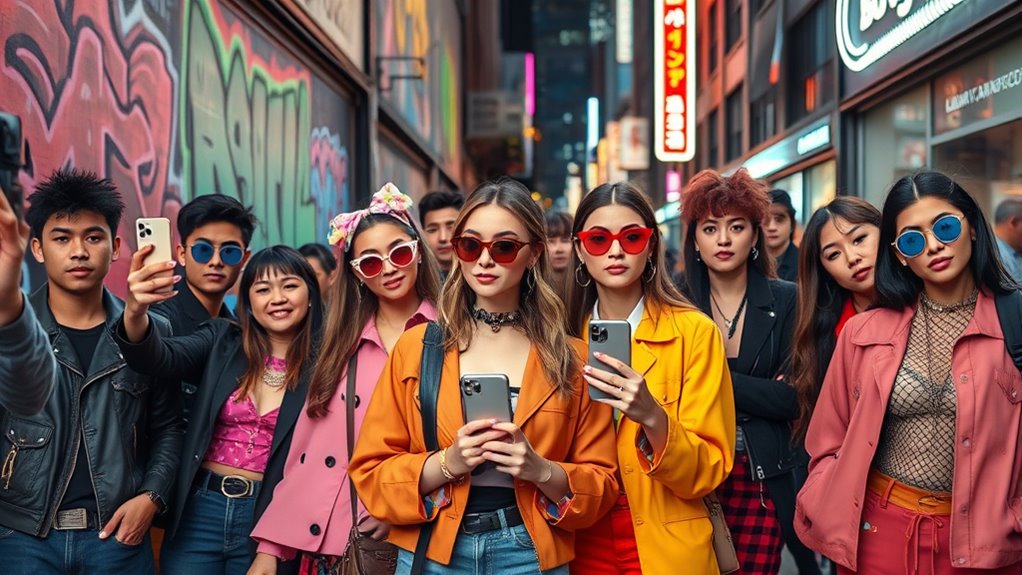
As digital technology advances, brands have shifted from one-way advertising to more interactive and personalized engagement with consumers. You now experience tailored content, direct messaging, and real-time feedback, strengthening brand loyalty. This evolution allows brands to gather valuable consumer insights, helping them refine products and marketing strategies. For example, understanding newborn sleep patterns enables brands to develop products that promote healthier sleep routines. Here are three key ways this transformation unfolds:
- Personalized interactions foster deeper emotional connections.
- User-generated content amplifies authentic brand advocacy.
- Real-time feedback enables quick adjustments and improved offerings.
Challenges and Criticisms of Social Media-Driven Fashion
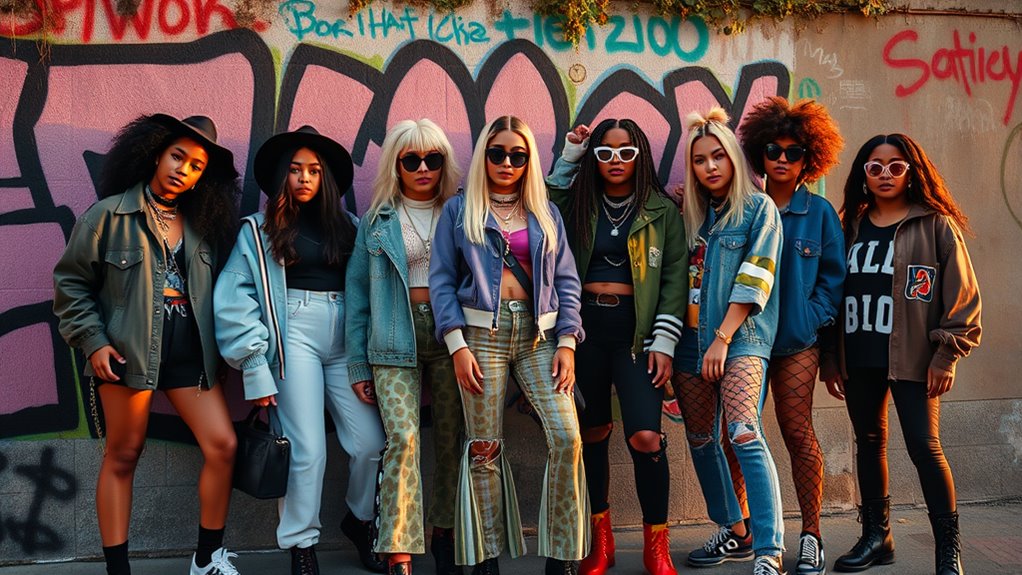
As you explore social media-driven fashion, you’ll notice it raises concerns about body image, with idealized images setting unrealistic standards. The fast fashion industry benefits from quick trends, but it also contributes to environmental harm and unethical practices. Authenticity becomes harder to verify, making it challenging to trust influencers and brands alike. Additionally, with the rise of Forsale 100, counterfeit and unauthorized merchandise can flood social media platforms, further complicating consumer trust.
Body Image Concerns
While social media has revolutionized fashion by making it more accessible, it has also intensified body image concerns. You might find yourself comparing your body to the often unrealistic standards promoted online, leading to increased body dissatisfaction. This constant exposure can also trigger self-esteem challenges, making you feel inadequate or pressured to conform. To understand this better:
- The curated images and filters can distort your perception of beauty and perfection.
- The emphasis on thin or toned bodies fuels unrealistic expectations.
- Constant validation through likes and comments can tie your self-worth to online approval.
- Additionally, home furnishings safety features in heated mattress pads highlight the importance of ensuring comfort and security, similar to how social media influences perceptions of safety and confidence in one’s body.
These factors contribute to a cycle where social media fosters insecurity and self-doubt, affecting how you view yourself and your body every day.
Fast Fashion Impact
Social media’s influence extends beyond body image concerns to shape how fast fashion dominates the industry. You see brands releasing new collections rapidly to meet trending demands, often sacrificing sustainable sourcing and ethical manufacturing. This quick turnaround encourages mass production with little regard for environmental impact or fair labor practices. Additionally, the industry faces criticism for its contribution to pollution, waste, and exploitation. Social media amplifies these issues by promoting instant gratification without considering the long-term consequences. Consumers are pressured to buy more frequently, fueling a cycle of overconsumption. While social platforms can raise awareness, they also enable fast fashion’s darker side, challenging brands to balance trend agility with responsible practices. Ultimately, the influence of social media demands a more conscious approach to fashion consumption. Furthermore, fostering sustainable practices and creative thinking around sustainable options can help mitigate some negative effects of fast fashion.
Authenticity Challenges
Authenticity in social media-driven fashion faces significant challenges as platforms often promote curated, idealized images that can mislead you about genuine style and value. This creates skepticism around brand authenticity and influencer transparency. To navigate these issues, consider:
- Questioning whether influencer claims about products are genuine or sponsored.
- Recognizing that many images are heavily edited or filtered, masking true product quality.
- Demanding transparency from brands about their manufacturing processes and marketing strategies.
These factors contribute to a growing mistrust among consumers seeking authentic connections. As you engage with fashion content, stay critical of the curated personas and carefully evaluate whether what’s presented aligns with real-world value and integrity. Authenticity remains a key challenge in maintaining honest fashion narratives online.
The Future of Fashion Culture in a Digital World
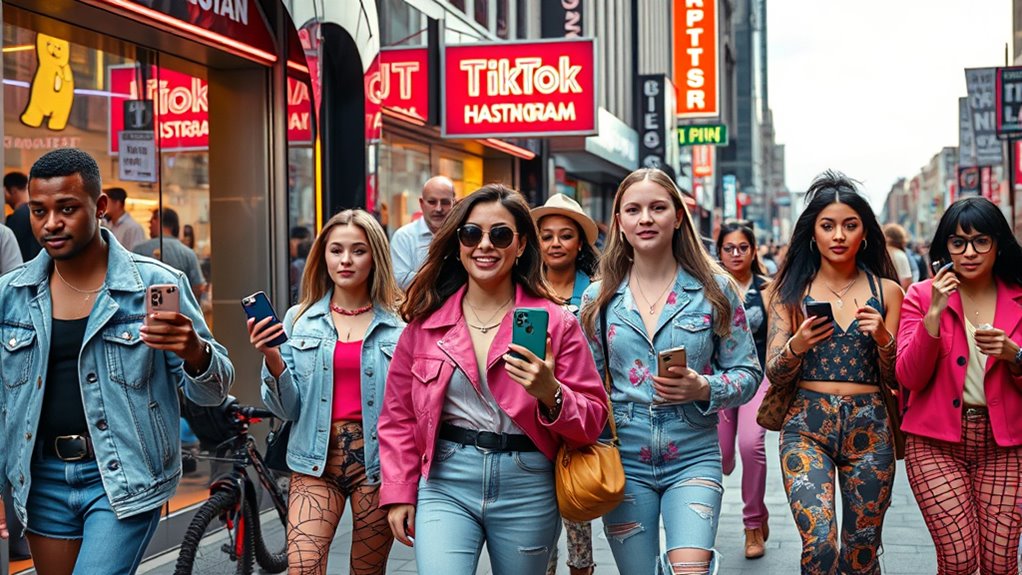
The future of fashion culture in a digital world is rapidly transforming as social media continues to shape how trends emerge and spread. Virtual fitting technology will become more common, allowing you to try on clothes virtually before purchasing, reducing waste and increasing convenience. Digital wearables, such as smart accessories and augmented reality (AR) clothing, will blend fashion with technology, creating personalized experiences. You’ll see brands leveraging these innovations to engage consumers directly through interactive platforms. As digital fashion evolves, you’ll also have the chance to participate in virtual fashion shows and showcase your style in online communities. This shift will make fashion more accessible, sustainable, and immersive, changing how you discover, try, and express your personal style in a digital landscape.
How Social Media Continues to Drive Innovation in Style
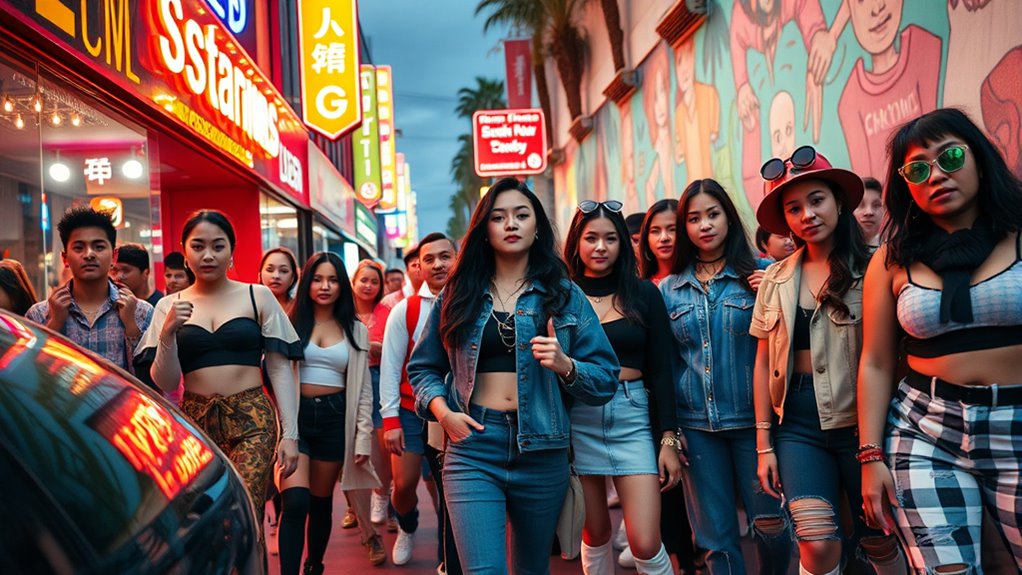
As social media continues to revolutionize fashion, it fuels rapid innovation by enabling you and brands to share ideas, showcase new styles, and collaborate instantly. Algorithm innovation plays a key role, tailoring content to your preferences and highlighting emerging trends faster than ever. This constant stream of personalized suggestions drives creators to push boundaries and experiment with fresh concepts. However, privacy concerns remain a challenge, as sharing innovative designs often involves sensitive data that can be misused or exploited. To navigate this evolving landscape, you need to stay aware of how algorithms influence what you see and understand the importance of protecting your personal information. Ultimately, social media’s dynamic environment keeps fashion evolving at a breakneck pace, inspiring innovation while demanding vigilance about privacy.
Frequently Asked Questions
How Has Social Media Influenced Luxury Fashion Brands’ Marketing Strategies?
Social media has revolutionized luxury fashion brands’ marketing strategies by emphasizing brand collaboration and boosting consumer engagement. You see brands partnering with influencers and celebrities to reach wider audiences quickly. They create interactive content, encouraging consumers to participate and share, which amplifies brand visibility. This approach makes luxury fashion more accessible and personalized, allowing brands to build stronger relationships with their audience and stay relevant in a fast-paced digital world.
What Ethical Concerns Arise From Influencer Marketing in Fashion?
Imagine influencer marketing as a shiny mirror reflecting fashion trends. But beware—this mirror can distort reality, raising authenticity concerns. You might be swayed by polished images, unknowingly falling into consumer manipulation. Ethical worries emerge when influencers hide sponsorships or promote products irresponsibly. As a consumer, you deserve transparency so you can make genuine choices, not just be dazzled by curated images that blur truth and illusion.
How Do Algorithms Affect the Diversity of Fashion Content on Instagram and Tiktok?
You see how algorithms affect content diversity on Instagram and TikTok by prioritizing popular trends and engaging posts, which can lead to algorithm bias. This bias often limits exposure to a wide range of fashion styles and voices, making the content more homogeneous. As a result, you might notice less representation of diverse fashion expressions, reducing the variety of styles and perspectives that reach your feed.
In What Ways Has Social Media Impacted Sustainable Fashion Movements?
You might think social media is just for fun, but it’s also sparking real change. It’s like a double-edged sword—spreading eco-conscious activism and viral sustainability challenges that put fast fashion under the microscope. You can share tips, support sustainable brands, or join movements instantly. This visibility helps make eco-friendly choices more mainstream, encouraging everyone to think twice before buying. Social media empowers you to be part of the green wave.
What Are the Long-Term Effects of Social Media on Traditional Fashion Industry Dynamics?
You see that social media causes significant cultural shifts, transforming how the fashion industry operates. It empowers consumers to demand transparency, inclusivity, and sustainability, forcing brands to adapt quickly. Long-term, this leads to more democratized fashion, where trends spread faster and smaller designers gain visibility. As a result, traditional industry dynamics evolve, emphasizing authenticity and consumer influence over solely brand-driven narratives, shaping a more responsive and diverse fashion landscape.
Conclusion
You’ve seen how Instagram and TikTok revolutionized fashion, making style more accessible and fast-paced. Did you know that over 60% of Gen Z shoppers say social media influences their purchases? As these platforms continue to push new trends and connect brands directly with fans, it’s clear that social media will keep shaping fashion’s future. Embrace the digital style wave—you’re now part of a global, ever-evolving fashion story.
